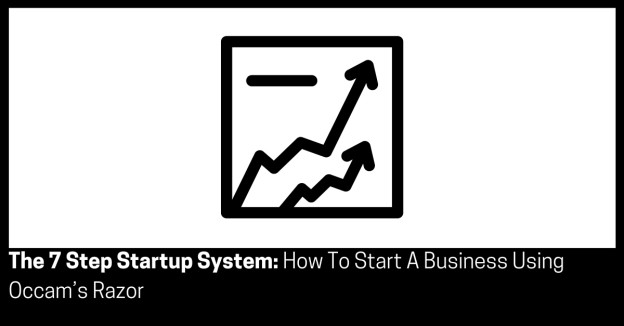Approximate read time: 48 minutes
This guide will show you how to start a business using Occam’s Razor.
That is:
“The simple and quick method is usually the best.”
If you are looking to start a business and:
- Don’t know where to begin;
- Have started and failed already; or
- Want to maximize your success.
…then this guide is for you.
I have been able to start businesses for myself and others in less than 1 hour, in some instances in under 15 minutes.
This sounds like bullshit, but I’ll explain exactly how to do this shortly.
Let’s start with some theory…
A market could be defined as a group of buyers and sellers.
In fact, a market only needs 1 buyer and 1 seller.
So, I had markets – mainly, university student groups—who I used to demonstrate this method.
Here is how it goes down:
I asked the group to list all the problems they had and documented them in real time.
(You get about 40 ideas total on average).
Then, I asked the same group who could solve any of the problems.
You get about half-a-dozen who raise their hand (they obviously can’t solve their own, because if they could, they wouldn’t have called it out in the first place).
You now have segments of buyers and sellers.
40 buyers and 12 sellers to make it simple.
(This increases your chances of finding a match between a buyer and a seller significantly more than 1 buyer and 1 seller and why it can be done in 15 minutes.)
Next, I tried to get buyers to agree to seller’s terms (which are usually based on price and a little on delivery times).
Here is how the conversation goes:
- Me: “So, out of the buyers, what price will you pay for the solution to your problem that the Buyer is offering?”
- Seller: “$20”
- Me: “Buyer, will you deliver your solution to the Sellers problem for $20?”
- Buyer: “No, but I’ll do it for $30”
This continues until the sellers and buyers can agree on terms (moderated by me).
Then once they agree, the seller is in business!
It is as simple as that, but of course people make it so much more complicated and spend a year of their life and $100,000 of their own money to fail and not even get to that point.
I’ve seen it multiple times.
It’s certainly a REAL situation!
This guide will help you de-risk your business and save time, money, and labour in the process, so that you don’t turn into one of these people.
Sure, you could be doing many other things beyond this, I get that, but this guide is designed as the shortest path to starting a business based on all my experience – the Occam’s Razor.

Why You Should Listen To Me
Before we begin, here are some of my other credentials related to creating startups:
- I brought Startup Weekend to Adelaide in 2012 (which now has completed 6 sold out events with 600+ local alumni);
- I am a Startup Weekend global facilitator (I’ve been involved in 10+ hackathon events, globally);
- I am a co-founder and current director of not-for-profit Startup Adelaide Inc. – a not-for-profit organisation that exists to foster and support the Adelaide tech startup sector;
- I am a co-founder and administration of the Startup Adelaide forum which has 700 members;
- I am the co-founder of Business Higher Education Round Table award winning program Venture Dorm (100+ alumni with total company valuations of $5.5M) which merged with Mobile Enterprise Growth Alliance to be Australia’s largest community pre-accelerator program;
- I am the former Director of Marketing for Mobile Enterprise Growth Alliance;
- I am the former Marketing Manager of New Venture Institute at Finders University;
- I am the Australia Day Citizen of the Year for Unley (2015) for my contribution to building the Adelaide startup ecosystem;
- I was recognised in Startup Daily’s “Top 50 Australian Startup Influencers” in Australia and “Mentors you should know in the startup space, Adelaide Edition”;
- I won an honorable mention in Australian Anthills 30 Under 30 award for my contribution to building the Adelaide startup ecosystem;
- I am an independent member of the Business and Economic Development Committee for Unley Council;
- I was on the judging panel for The Australian Centre for Social Innovation’s Aging Challenge in 2015; and
- I am a workshop facilitator for Flinders Universities Business School in Enterprise and innovation.
I’ve directly helped 400+ startups (of those which have raised capital, their current combined company valuations are $5.5M) get their products, services, or solutions out to market through various award-winning training programs.
Not only that, over the last four years I have successfully released over a dozen new products, services, or solutions for myself and on behalf of others; including franchises of international brands (which have become dominant players in their industry).
Many of these have been done with $0 marketing spent, no prospect or customer list, AND in some cases, no product, service, or solution at the time of launch.
I can see how this sounds preposterous.
But it can be done with the right process…
Startups usually go through 3 stages when they begin:
- Problem/solution fit – this is defined by finding if a market exists and if you can create a solution;
- Product/market fit – this is defined by finding if your solution is desirable to the market proven by making a sale; and
- Scaling – this is defined by creating a business around stage 1 and 2 above.
This guide will focus on the first 2 stages.

My Promise To You
My promise to you is that this guide will help you start a new business in 4 weeks or less guaranteed.
Here I am deifying “start” as making 1 sale.
Why is this?
Here is the harsh reality:
You are not in business until you make a sale.
Let me repeat:
YOU ARE NOT IN BUSINESS UNTIL YOU MAKE A SALE.
Everything else is “playing business.”
A business only works when the cash registers are ringing.
If you thing I am wrong, just stop here – save us both time.
Business cards, a “nice logo,” bank accounts, registering a company, and building a website ad nausea counts for nothing until you have a sale.
In fact, don’t get business cards, a “nice logo,” bank accounts, registration of a company, or a website when you start.
That is a distraction from your core purpose – to make 1 sale.
Remember this is starting a business using Occam’s Razor.
After you have made 1 sale, you can get business cards, a “nice logo,” bank accounts, registration of a company, a website and everything else a business needs.
But not before.
You are probably saying – “But I need a cool logo to be taken serious. Branding is important.”
Yes, branding is important, but you are nowhere near that point as I’ll discuss soon.
No one significant will know that you don’t have a cool logo at this stage.
In addition, when someone has a headache, they don’t care if it’s brand name or generic aspirin; they only care if the product works, and fast.
When dealing with first customers, this is the same.
Wait until you make a sale to work on the brand.

The Scientific Method
Unless you have a sale, your assumptions and opinions about whether your “business idea” will work or not are moot.
The scientific method related to startups begins with making assumptions and observations about customers and markets and their pains and wanted gains.
I’m sure you have done this to come up with a “business idea.”
Next, you do some research with customers and markets and about their pains and wanted gains.
Next, you make a prediction about the outcome of your assumptions and observations.
This is your hypothesis.
Next, you develop an experiment to test your prediction of the outcome.
Next, you test your experiment and gather evidence for or against your hypothesis.
If needed, based on evidence, you change and repeat the experiment.
Finally, you have a conclusive theory about your original assumptions and observations.
You want to validate or de-validate your assumptions.
This guide is based on loosely on the scientific method.
This has also been called the Lean Startup method by Eric Ries where entrepreneurs:
- Build (making assumptions and observations, research, hypotheses and experiments);
- Measure (testing experiments and gathering evidence); and
- Learn (declaring a conclusive theory.)

Do Things That Don’t Scale
Venture Capitalist and co-founder of Y Combinator, Paul Graham once said:
“Do things that don’t scale.”
Meaning do things manually until you don’t have enough time in the day then automate them.
Don’t get business cards, a “nice logo,” bank accounts, register a company, or build a website until you need them!
You don’t need them at this stage.
Pursuing them is unfocused and an excuse for taking real action on things that move the needle.
That being making a sale.
Everything else has no purpose other than to make you feel good about something that doesn’t progress your business.
It also protects you from the harsh reality that your “business idea” probably won’t work.
“No one likes to hear their baby is ugly.”
They do everything they can to prevent hearing this even if it means they never start up.
Ask yourself, “Does this apply to me?”
If it does, again, stop here – save us both time.
Most people have a “business idea.”
A “business idea” is just a different name for a product, service or solution.
In 99.9% of cases, a “business idea” is based on what the founder wants to create, rather than what the market needs.
It’s putting the cart before the horse.
The late Steve Jobs once said, “Customers don’t know what they want until we’ve shown them.”
Unless you are Steve Jobs (you are not, sorry to burst you bubble) this doesn’t apply to you, and you can’t create products like the iPhone that the market doesn’t even know they need yet.
A more realistic take away is as follows:
Customers don’t know what they want, but they certainly know what problems they have!
The first formal thing I learned in sales at age 14 was, “The customer is king, and they are always right.”
Neither the founder, the CEO or the company is king, nor are they right.
This is a better mantra for you the newbie startup founder.
This guide is here to help you master the startup process.
Here are the elements…
- Step 1: Take Stock
- Step 2: Market Alignment
- Step 3: Contact List
- Step 4: Market Research
- Step 5: Sales Script
- Step 6: Start Selling
- Step 7: Product Creation
Let’s begin with…

1) Take Stock
…Step 1 is about Taking Stock of your skills, knowledge, interests and experiences.
This is important because it will set you up for streamlining startup success.
There is no point trying to acquire new skills, knowledge, interests and experiences if you want to start a business quickly, it simply would take too much time.
That being making a sale.
As I bet you have a “business idea” already, this step helps you strike a balance between your “business idea” and what the market wants.
So, I encourage you to abandon your “business idea” and pick an industry or customer segment that aligns to your skills, knowledge, interests and experience.
Remember what I said previously?
Customers don’t know what they want, but they certainly know what problems they have.
Start with listing all your skills, knowledge, interests and experiences.
Don’t filter them, get as many as possible.
Of course, the exact details of how to do this are beyond the scope of this guide.
This leads to the Market Alignment step…

2) Market Alignment
…Step 2 is about aligning your skills, knowledge, interests and experiences with market problems and needs, away from pain or towards pleasure.
This is important because customers purchase products, services or solutions when they want to move away from their current situation and towards a new one – that being away from pain or towards pleasure, ideally in the fastest way possible.
Your product, service or solution is actually a barrier to moving customers away from pain or towards pleasure.
Let me explain…
Think about it this way; the most direct path for a customer would be a short two-step path:
- Current situation (pain); then
- New situation (pleasure).
With your product, service or solution, the path for a customer is actually a longer three-step path:
- Current situation;
- Your product, service or solution; then
- New situation.
This is the reason humans want magic pills or silver-bullet products, services or solutions, and want results yesterday!
Magic-pills or silver-bullets rarely exist, so you need to sell people what they want (two-step path), but you also have to give them what they need (three-step path).
The more you can speed up or automate your product, service or solution, the better.
You want to reduce the time and effort it takes to move from Step 1 to Step 3 to a minimum.
The fastest or simplest way you can move a customer away from pain or towards pleasure, the more value you add to them and the more you can charge for doing so via your product, service or solution.
The mechanism for this is your product, service or solution offer.
Start by listing customer segments or industries or categories that are related to your skills, knowledge, interests and experiences you listed in Step 1.
A customer segment could be defined as niche of a market that share similar characteristics, that other niches do not.
This may be based on demographic (age, gender and so on) or psychographic (interests, likes and so on) criteria.
Of course, the exact details of how to do this are beyond the scope of this guide.
This leads to the Contact List step…

3) Contact List
…Step 3 is about building a customer segments or industries contact list.
This is important because being in direct contact with people allows you to consistently communicate with them about market research and selling.
Here we come across the first decision tree.
Do you have a contact list of relevant and related customer segments?
If you do not have a contact list of relevant and related customer segments, you need to create one.
Here we are going to target friends and family.
The reason being, they know, like, and trust you already.
And we know marketing and sales only happen when prospects and customers know, like and trust your business.
We want to make your startup journey as easy as possible because in Step 6 you will be selling to your friends and family.
Understand that if you can’t sell your product, service or solution (which we will cover in Step 6) to friends and family, you have no chance in selling to strangers who don’t know, don’t like, and don’t trust you.
This is especially true when they need to factor in opportunity costs as well.
Your friends and family will forgive you, whereas strangers will not.
Opportunity Costs
This is an evaluation of opportunity costs.
An opportunity cost is the cost of an alternative course of action that must be forgone in order to pursue a certain action.
The resources they may call upon could be:
- Capital;
- Time;
- Effort;
- Attention; and
- Networks and connections;
- To name a select few…
The basic strategy here is to:
- Reduce their perceived risk in losing those resources in choosing your brand; and
- Increase the perceived urgency.
This could be done through the following:
- Asking questions to show you understand their situation;
- Giving away freebies;
- Showing your credibility through success stories, testimonials and case studies;
- Highlighting your credentials and expertise;
- Comparing price and other currencies;
- Offering product service or solution guarantees; and
- So on…
But, the easiest path is to contact (and then sell to) friends and family – the Occam’s Razor.
Your goal here is to create a seed list of prospects and customers by collating email addresses from where you can:
- Your email address book; and
- Your contacts on LinkedIn, Facebook and other social network where you have a presence.
LinkedIn is handy in that it allows you to export your contacts including emails.
And if you setup a new Yahoo! Mail account you can download all your Facebook friends’ email addresses.
You should easily be able to get 20+ contacts who may have a pain you can turn into a gain.
Okay, if you do have a contact list of relevant and related customer segments, you need to then find and list all pains and wanted gain the segment has.
Don’t fall into the trap of thinking you know what these are (i.e. assumptions).
You won’t know what they are until you have direct contact with potential customers.
So, how do you do this?
Through market research.
Of course, the exact details of how to do this are beyond the scope of this guide.
This leads to the Market Research step…

4) Market Research
…Step 4 is about Market Research.
This is the first part of problem/solution fit I mentioned previously.
This is important because you need to know your prospects and customers’ dreams, fears, problems, needs, mistakes and so on – the things that your products, services or solutions address.
Here we come across the second decision tree.
If your prospects and customers do not want to talk to you about their pains and gains that your product, service or solution can solve, then no further action is needed with that segment.
If your prospects and customers do want to talk to you about this, then you need to ask them specific market research questions.
Research Markets
You need to understand these and several other insights on a very deep level.
External insights are about pains and gains.
Internal insights are about your products, services and solutions.
Most people do not know their prospects and customers’ hot buttons and what makes them really tick.
Market research is success insurance!
What is market research?
Market research “is any organized effort to gather information about customers.”
Amazon.com uses a process called “working backward” for new product, service or solution creation.
Amazon’s CTO, Werner Vogel, said, “Start with your customer and work your way backward until you get to the minimum set of technology requirements to satisfy what you try to achieve.”
They write the press release, the Frequently Asked Questions, and user manual all before the product, service or solution is created.
One of the best quotes I have read on this is by serial entrepreneur, Steve Blank:
“Marketing’s primary role at a startup is to drive sales. Marketing’s job is to make the VP of Sales the richest person in the company. How does marketing do that? Well, marketing’s job number one was to understand customers’ needs, desires, etc. and make sure engineering understood those as well.”
Marketing and sales require some fundamental elements such as:
- Qualifying;
- Credentials;
- Benefits;
- An offer;
- Call to action; and
- So on…
All of your market research must be related to your sales script, but it also should be related to the rest of your marketing and sales communication and offers.
Anything additional is superfluous.
You want to do as copywriter Robert Collier once said: “Enter into the conversation that your prospect is already having in their own mind.”
What?
Humans love homeostasis.
Homeostasis is a condition that remains stable and relatively constant.
Humans are twice as motivated to move away from pain then they are to move towards pleasure.
This makes sense when you consider Maslow’s Hierarchy of Needs…
The upper needs, which not all humans can or want to achieve, are about seeking pleasure – things like gaining prestige – and the lower needs are about avoiding pain – things like having shelter from the harsh weather.
This is the logic behind purchases:
Someone has a pain or problem, which means they are not in homeostasis and they are outside their comfort zone.
As humans love homeostasis, they will do anything to return FAST to that stable and relatively constant condition.
Because of this, they are highly motivated to find a solution that will do this.
Any product, service or solution that communicates (through marketing and sales) that will provide the sought outcome or benefit (through the offer) will be purchased.
This lack of homeostasis also means they are highly willing to talk about it and will give you great insight into their worldview.
Your marketing and sales communication should mirror the exact phrases they use.
They should be saying, “This is exactly what I need!” when you communicate.
Human’s also love instant gratification and want to get back to their comfort zone FAST.
They see the value and not the opportunity cost (which I will discuss in-depth later), as they are solely focused on getting back to their comfort zone.
Most people think that we have a conscious thought and then act on it.
MRI scans actually show the reverse: we have an unconscious thought, we take action on it and seven seconds later we become conscious of that original unconscious thought.
This is called confabulation.
Confabulation is where we create a story and rationalize with logic after the fact.
Humans love to buy (biology, emotion, the past, stories) and hate being sold to (logic).
Loving to buy, actually means we are in homeostasis and back in our comfort zone and in “control.”
We get a boost of self-esteem.
Hating being sold to actually means we have no pain or urgency, as we are being convinced to do something and we feel resentment.
Gather a prospect list and ask the following six questions:
- “What are their biggest challenges, or what results are they trying to achieve?”;
- This will give you benefits;
- “What is the magic pill they think will achieve this?”;
- This will give you features and product, service or solution type;
- “If they could solve this immediately, how much would it be worth?”;
- This will give you price range;
- “Where and how are they looking to solve this?”;
- This will give you marketing and sales channels;
- “What are they considering buying?”;
- This will give you competition and value proposition;
- “What will happen if they don’t get this solved?”;
- This will give you motivation and concerns.
Of course, there are so many more questions to ask in market research. The, the exact details of how to do this are beyond the scope of this guide.
Other questions to ask include, external factors, such as demographics and, pains and gains, and internal factors such as product, service, or solution promotional partners.
The questions revolve around a few main areas, both external and internal:
- Demographics;
- Pains;
- Gain; and
- Solutions.
It is worth noting that you should not use surveys (quantitative results have a place, such as validating data, but it’s not here).
The process of asking or interviewing them, in the first instance, is qualitative research, which is investigative research to understand their answers deeply by asking further questions, if necessary.
This means it is best to talk to people face-to-face or over the phone, instead of using email or surveys.
There is a place for surveys, which comes later.
Offering a survey at this stage means that you run the risk of asking leading questions.
In law, there is an evidential question called a leading question.
A leading question is a question you ask to hear the information you want to hear.
Put another way, it is a question that prompts or encourages the answer sought.
In other words, it’s information that will confirm any bias you already have.
A survey only has limited information that has no scope for organic follow-up questions like an interview does.
It misses a lot of vital information you don’t know or don’t know that you don’t know.
You need to be asking the “5 Why’s” behind each answer to get to core of the answer:
Why, why, why, why, why!
Your bias and assumptions may not actually align with what your prospects and customers truly want.
These biases are not helpful in the context of marketing and sales, as it will mean you are not addressing exactly what your prospects and customers need.
After you have done this with one prospect or customer, you need to repeat it at least 20 times with 20 plus other prospects or customers, or until you see answers with common denominators starting to emerge.
Don’t count the outlines.
The reason for this is statistical significance.
Once you have completed your market research, then you can confirm and validate this research via a survey.
Here is where surveys are relevant.
This is quantitative research.
You need to add the common denominators to the survey and ask if they are true.
Again, you need to repeat this at least 20 times with 20 plus prospects or customers, or until you see answers with common denominators starting to emerge.
Don’t count the outlines.
The reason for this is statistical significance.
Of course, the exact details of how to do this are beyond the scope of this guide.
This leads to the Sales Script step…

5) Sales Script
…Step 5 is about creating a sales script.
This is the second part of problem/solution fit I mentioned previously.
This is important because nothing matters until you have a sale.
Ask To Buy
You will be asking friends and family TO BUY, not IF THEY WOULD BUY.
This is a very subtle yet, crucial distinction, so it’s worth repeating:
Ask to buy, not if they would buy.
Everyone will say they will buy, because they don’t want to hurt your feelings.
When you ask them to buy, like actually take money out of their wallet and give it to you for your product, service or solution, it becomes real.
You can test this: ask people if they would buy, and when they say “yes” ask them to buy and they will come up will all kinds of objections as why they can’t.
That is “not wanting to hurt your feelings” in action.
Help them save face and just ask them to buy in the first place.
At this point, prospects will have now become customers.
This is a very powerful psychological buying decision.
Objections
Let’s get a little side tracked with sales objections…
Here is a list of some common buying concerns:
- Have no need or willingness to pay;
- Have the wrong timing and it’s not urgent;
- Have no buying authority or ability to pay;
- Have no budget or ability to pay;
- Do not know what they get with the product, service or solution;
- Do not like or trust your brand;
- Do not believe (i.e. trust) the product, service or solution will work;
- Do not believe (i.e. trust) the product, service or solution will work for them;
- Do not think the product, service or solution is valuable; and
- Many, many more…
These main objections could be expressed by prospects and customers in the following ways:
- “I’m not interested”;
- “I can’t afford it”;
- “I can’t make the decision”;
- “Not right now”;
- “How do I know it works?”;
- “This is risky for me”;
- “I don’t know you”;
- “What do I get?”; and
- “I’ll think about it.”
Of course, these are just illustrations as the objections could be expressed in infinite other ways.
After you have determined their buying objections, it’s time to address them so they become customers.
Here are some tried-and-true ways to address the same sales concerns listed previously:
- Ask them demographic and psychographic questions to re-qualify and segment them and explain what type of customer the product, service or solution is intended to benefit and those it cannot help;
- Re-contact them at a later date, inject scarcity, and provide incentives or bonuses along with the purchase;
- Same as 1;
- Ask them demographic and psychographic questions to re-qualify and segment them and ask who the decision maker is;
- Explain the product, service or solution features;
- Give them your product, service or solution expertise, credibility, or credentials in the form of informational and educational marketing and sales content to teach them about your brand and give them the brand story behind the product, service or solution;
- Provide them with social proof in the form of testimonials and success stories, give them the story behind the product, service or solution, give them your product, service or solution expertise, credibility or credentials in the form of informational and educational marketing and sales content to teach about your brand and explain what type of person the product, service or solution is intended to benefit and those it cannot help;
- Provide social proof via case studies, provide a risk reversal in the form of a money back guarantee, give them the story behind the product, service or solution, give them your product, service or solution expertise, credibility or credentials in the form of informational and educational marketing and sales content to teach about your brand, show them the benefits, advantages, results or outcomes that your product, service or solution provides and show your product, service or solution is different or unique; and
- Give them the product, service and solution price and translate the value of that price for them into different currencies, such as time and effort.
And based on these, here are some potentially related principles of influence based on Robert Cialdini’s book Influence: The Psychology of Persuasion:
- Nothing of note;
- Nothing of note;
- Nothing of note;
- Scarcity;
- Proof, Authority and Reciprocity;
- Proof, Authority and Reciprocity;
- Liking (as well as knowing & trusting your brand), Reciprocity and Authority;
- Nothing of note; and
- Nothing of note.
All of these ways of addressing concerns are tied together with the “Commitment and Consistency” principle of influence in the same book.
Okay, back to the process.
The Sales Script
You need to create a product offer and outline the sales script.
Use the formula also known as the acronym, AIDA:
- (A)ttention;
- (I)nterest;
- (D)esire; and
- (A)ction.
The term and format is attributed to Elias St. Elmo Lewis.
When discussing advertising, Lewis said “The mission of an advertisement is to attract a reader, so that he will look at the advertisement and start to read it; then to interest him, so that he will continue to read it; then to convince him, so that when he has read it he will believe it. If an advertisement contains these three qualities of success, it is a successful advertisement.”
This is what they mean:
- You first need to attract prospects’ or customers’ attention, cut through and stand out among all the other communication they are receiving;
- You then need to engage prospects or customers so they listen to your message;
- You then need to help them convince themselves that they desire your offer; and
- You finally need them to act on that desire.
These should take into account sales script best practice, that is, stating the:
- Brand creation story;
- Brand credibility;
- Value proposition;
- Features;
- Benefits;
- Advantage;
- Who it is for and not for;
- The offer;
- The price;
- That value translated into other currencies;
- Guarantees;
- Bonuses and incentives;
- Testimonials and case studies;
- Call to action;
- And so on…
This formula is consistent across modality.
The sales script needs to be comprehensive, but in dot-point form.
There should be enough to remind you of the information you want to communicate if you were to speak to them.
It cannot be vague.
This will give you the layout and format of the content.
Start this step with the end in mind – the call to action and what you want the prospect or customer to do once they have consumed it.
Then write the headline to act as a hook to start consuming the sales script.
Next, write out the specifics of the information, then the introduction, and finally the transitions.
Once you have outlined the content in detail, it is time to fill out the content so it makes sense.
This can take a lot of time and is probably the most time-consuming part of the process.
Margins
Most startup founders never build all costs in at the start, such as their wages – they just write that off as volunteering.
Tim Ferriss explains how to do this in The Margin Manifesto: 11 Tenets for Reaching (or Doubling) Profitability in 3 Months:
“Is your pricing scalable? Many companies will sell direct-to-consumer by necessity in early stages, only to realize that their margins can’t accommodate resellers and distributors when they come knocking. If you have a 40% profit margin and a distributor needs a 70% discount to sell into wholesale accounts, you’re forever limited to direct-to-consumer… unless you increase your pricing and margins. It’s best to do this beforehand if possible – otherwise, you’ll need to launch new or “premium” products — so plan distribution before setting pricing.”
Translation
Once you have created your sales script in one format, you then need to “translate” that version into many other versions, formats or designs.
The reason behind this is that you can get far more versions for an incremental bit of extra work.
These could include:
- Written;
- Audible;
- Visual;
- Live;
- Canned; and
- For both digital or physical use.
These other versions of sales scripts are based on the foundation of text you created already.
The most obvious is that a text sales script can be used as an in-person sales script.
Of course, the exact details of how to do this are beyond the scope of this guide.
This leads to the Start Selling step…

6) Start Selling
…Step 6 is about selling your offer, not your product (remember, startup entrepreneurs won’t have created one yet).
This is product/market fit I mentioned previously.
This is important because nothing matters until you have a sale.
Here you will distribute your sales script through any of the “translated” versions to your contact list who you interviewed previously about pains and wanted gains.
You will be doing this in person – face-to-face or over the phone and not using email or surveys as discussed previously.
You will also repeat this process as many times as needed until you make your first sale.
Selling is “scary” as you open yourself up to rejection – again, “no one likes to hear their baby is ugly.”
But, I have given you some tools to overcome objections and because you are selling to friends and family the “scary” factor is significantly reduced.
This is equivalent to a “soft launch” or taking pre-sales as you don’t yet have a product (Step 7).
You can always issue a refund if you cannot deliver and friends and family will be more accepting of this, than anyone else, especially strangers.
It’s worth re-mentioning brand implications, previously discussed.
As it is a “soft launch” to friends and family, no one significant will know that you don’t have a cool logo at this stage.
Of course, the exact details of how to do this are beyond the scope of this guide.
This leads to the Product Creation step…

7) Product Creation
Step 7 is about Product Creation.
This is important because customers purchase products, services or solutions when they want to move away from their current and towards a new situation.
This is part of Scaling mentioned above.
As scaling is not a focus of this guide, I will only briefly mention it.
Do you have a product, service or solution?
If you have been following this guide, you should have abandoned your initial “business idea,” meaning you don’t have a product, service or solution yet.
Once you have made a sale, you need to drop everything else and work as quickly as you can to deliver a product, service or solution on your sales promise.
Now you need to create a product, service or solution based on real customer feedback and pre-sales to actual customers.
Here is where you create your “business idea.”
Product creation is a massive topic and hard to cover here because there are so many types:
- Physical;
- Digital;
- Products;
- Services;
- Solutions and
- So on…
Yep, it’s a big topic and I’ll assume you as the entrepreneur know how to solve your prospects problems based on Step 1.
Of course, the exact details of how to do this are beyond the scope of this guide.

Take Action
You made it.
You now have a solid plan for starting a business quickly and easily.
That’s the full 7 Step Startup System, and it will be more than enough for you to get started on your own.
And if you’re serious about starting a business quickly and easily, the logical next step is to contact me to help you do it yourself, have me do it with you, or have it all done for you.
This maybe the momentum you need to start a business.
Do you want more like this?
Join below to be notified immediately about new content and more. No annoying daily emails and no spam – just good content when it’s posted.


I like your description of the start-up process. Basing it on problem fit, market fit, and scaling makes a lot of sense. Business planning is pretty complex and even exploring a market could use skills you don’t have. It might be useful to outsource some skills to advisors.